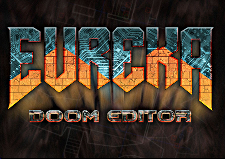Main Menu
Links
Running Eureka
You can run Eureka a number of ways: from double clicking its binary after downloading and unpacking (the Windows and macOS packages), from the desktop menu (when installed e.g. from the Debian repository), or from the command line in a terminal emulator.
Note that Eureka needs a game IWAD in order to run. When it cannot find one, then the "Manage Wads" dialog will open up and you can use the "Find" button to locate one. If you do not own any of the games which Eureka supports, there is always the project "FreeDoom" which is completely free.
The rest of this page describes running Eureka from the command line.
Option Syntax
Option names begin with either one or two dashes. Short options consist of a single letter after a single dash, like -f and -w, whereas long options are a whole word following one or two dashes, such as --file and --warp. Long options are shown on this page with two dashes, but a single dash is supported too, because that syntax was accepted by the original DOOM engine and various source ports.
Some options accept a parameter after them. There must be a space between the option name and the parameter, even for short options, and equal signs cannot be used. A few of the options accept multiple parameters, and each parameter must be separated by spaces too.
When the first thing on the command line is not an option, Eureka treats it as the filename of a pwad to edit. Multiple files can be specified this way.
Examples of valid options:
-w 1
-warp 2
--warp 3
Examples of invalid options:
-w missing the parameter
-w2 no space between option and parameter
-w=3 equal signs cannot be used
General Options
-f --file <filename>....
-w --warp <map>
-i --iwad <filename>
-m --merge <filename>....
.ugh extension).
-p --port <name>
-h --help
-v --version
-q --quiet
-d --debug
Configuration Options
The following options control how Eureka finds some important files and directories. They are not particular useful per se, but may be needed for special circumstances.
--install <dir>
--home <dir>
.eureka folder in the user's $HOME directory.
--log <file>
logs.txt in the home directory.
--config <file>
config.cfg in the home directory.
Environment Variables
The following environment vars are recognized by Eureka:
DOOMWADDIR
DOOMWADPATH
